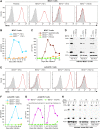HIV-1 propagation is highly dependent on basal levels of the restriction factor BST2
- PMID: 34714669
- PMCID: PMC8555903
- DOI: 10.1126/sciadv.abj7398
HIV-1 propagation is highly dependent on basal levels of the restriction factor BST2
Abstract
BST2 is an interferon-inducible antiviral host protein antagonized by HIV-1 Vpu that entraps nascent HIV-1 virions on the cell surface. Unexpectedly, we find that HIV-1 lacking Nef can revert to full replication competence simply by losing the ability to antagonize BST2. Using gene editing together with cell sorting, we demonstrate that even the propagation of wild-type HIV-1 is strikingly dependent on BST2, including in primary human cells. HIV-1 propagation in BST2−/− populations can be fully rescued by exogenous BST2 irrespective of its capacity to signal and even by an artificial BST2-like protein that shares its virion entrapment activity but lacks sequence homology. Counterintuitively, our results reveal that HIV-1 propagation is critically dependent on basal levels of virion tethering by a key component of innate antiviral immunity.
Figures








Similar articles
-
Multi-functional BST2/tetherin against HIV-1, other viruses and LINE-1.Front Cell Infect Microbiol. 2022 Sep 13;12:979091. doi: 10.3389/fcimb.2022.979091. eCollection 2022. Front Cell Infect Microbiol. 2022. PMID: 36176574 Free PMC article. Review.
-
Differential Control of BST2 Restriction and Plasmacytoid Dendritic Cell Antiviral Response by Antagonists Encoded by HIV-1 Group M and O Strains.J Virol. 2016 Oct 28;90(22):10236-10246. doi: 10.1128/JVI.01131-16. Print 2016 Nov 15. J Virol. 2016. PMID: 27581991 Free PMC article.
-
Contribution of the Cytoplasmic Determinants of Vpu to the Expansion of Virus-Containing Compartments in HIV-1-Infected Macrophages.J Virol. 2019 May 15;93(11):e00020-19. doi: 10.1128/JVI.00020-19. Print 2019 Jun 1. J Virol. 2019. PMID: 30867316 Free PMC article.
-
Vpu and BST2: Still Not There Yet?Front Microbiol. 2012 Apr 9;3:131. doi: 10.3389/fmicb.2012.00131. eCollection 2012. Front Microbiol. 2012. PMID: 22509177 Free PMC article.
-
Role of the endosomal ESCRT machinery in HIV-1 Vpu-induced down-regulation of BST2/tetherin.Curr HIV Res. 2012 Jun;10(4):315-20. doi: 10.2174/157016212800792414. Curr HIV Res. 2012. PMID: 22524180 Review.
Cited by
-
The ectodomain sheddase ADAM10 restricts HIV-1 propagation and is counteracted by Nef.Sci Adv. 2025 Apr 18;11(16):eadt1836. doi: 10.1126/sciadv.adt1836. Epub 2025 Apr 18. Sci Adv. 2025. PMID: 40249826 Free PMC article.
-
AP-2 Adaptor Complex-Dependent Enhancement of HIV-1 Replication by Nef in the Absence of the Nef/AP-2 Targets SERINC5 and CD4.mBio. 2023 Feb 28;14(1):e0338222. doi: 10.1128/mbio.03382-22. Epub 2023 Jan 9. mBio. 2023. PMID: 36622146 Free PMC article.
-
Multi-functional BST2/tetherin against HIV-1, other viruses and LINE-1.Front Cell Infect Microbiol. 2022 Sep 13;12:979091. doi: 10.3389/fcimb.2022.979091. eCollection 2022. Front Cell Infect Microbiol. 2022. PMID: 36176574 Free PMC article. Review.
-
Promotion of BST2 expression by the transcription factor IRF6 affects the progression of endometriosis.Front Immunol. 2023 Apr 18;14:1115504. doi: 10.3389/fimmu.2023.1115504. eCollection 2023. Front Immunol. 2023. PMID: 37143676 Free PMC article.
-
Metformin facilitates viral reservoir reactivation and their recognition by anti-HIV-1 envelope antibodies.iScience. 2024 Aug 5;27(9):110670. doi: 10.1016/j.isci.2024.110670. eCollection 2024 Sep 20. iScience. 2024. PMID: 39252967 Free PMC article.
References
-
- Neil S. J., Zang T., Bieniasz P. D., Tetherin inhibits retrovirus release and is antagonized by HIV-1 Vpu. Nature 451, 425–430 (2008). - PubMed
-
- Sauter D., Schindler M., Specht A., Landford W. N., Munch J., Kim K. A., Votteler J., Schubert U., Bibollet-Ruche F., Keele B. F., Takehisa J., Ogando Y., Ochsenbauer C., Kappes J. C., Ayouba A., Peeters M., Learn G. H., Shaw G., Sharp P. M., Bieniasz P., Hahn B. H., Hatziioannou T., Kirchhoff F., Tetherin-driven adaptation of Vpu and Nef function and the evolution of pandemic and nonpandemic HIV-1 strains. Cell Host Microbe 6, 409–421 (2009). - PMC - PubMed
Grants and funding
LinkOut - more resources
Full Text Sources

